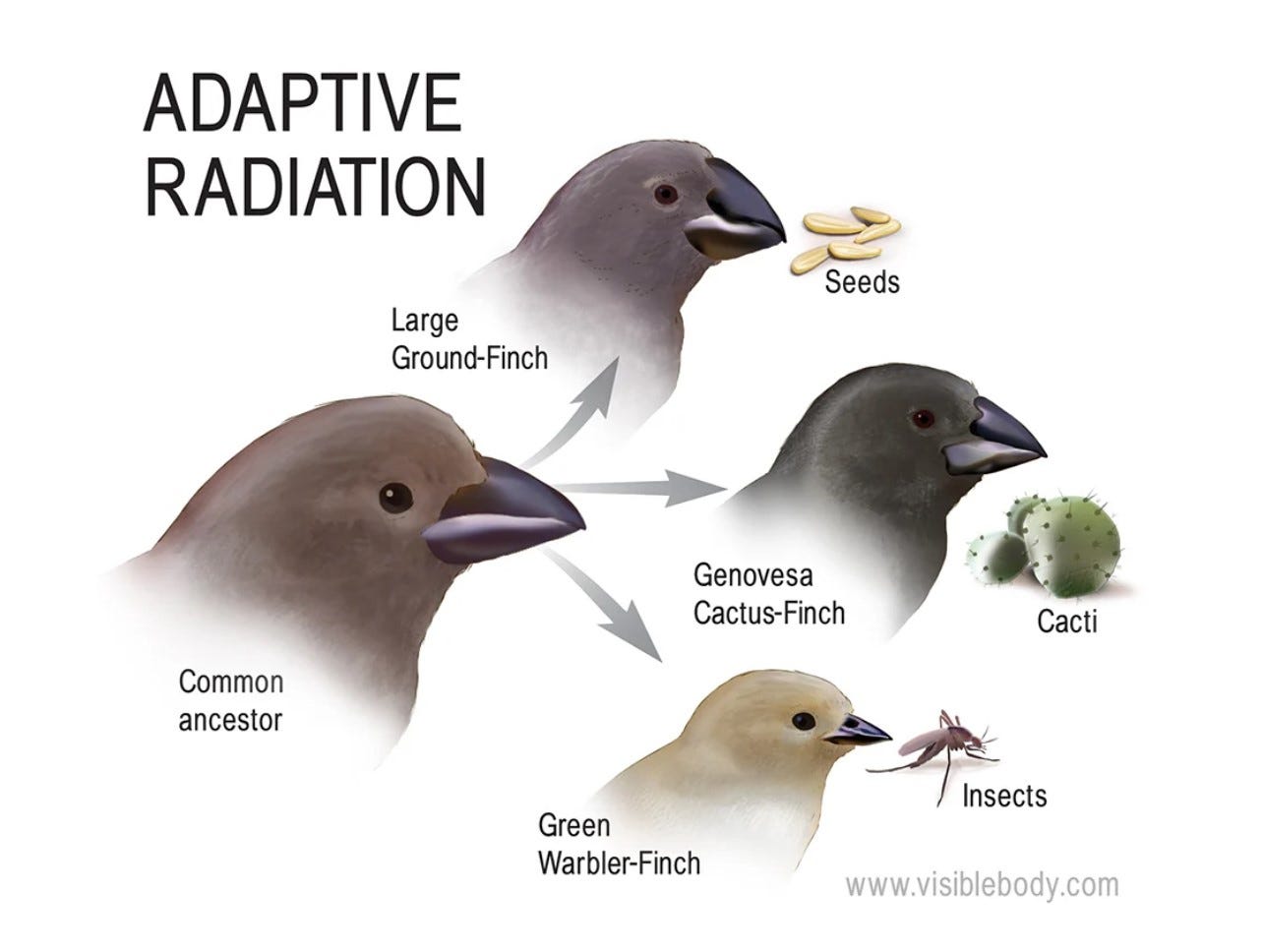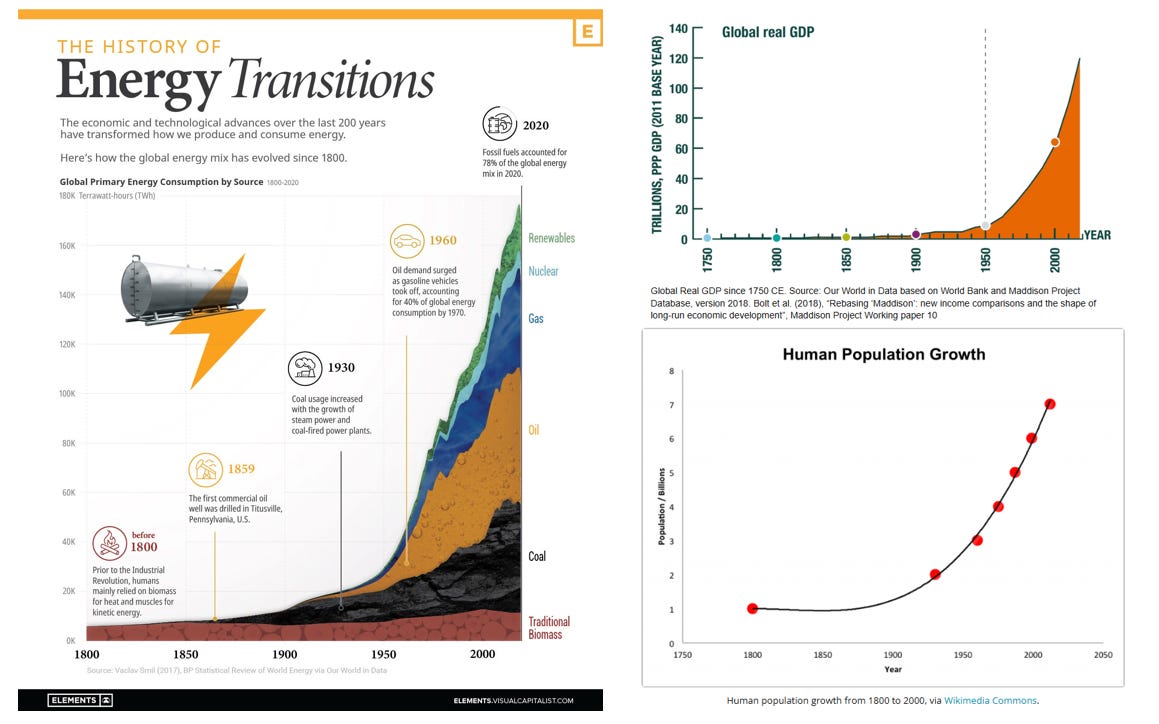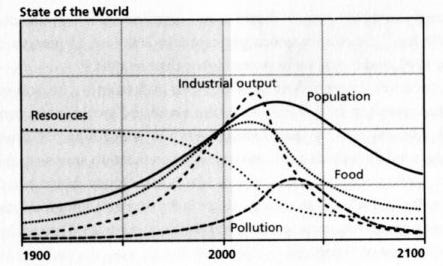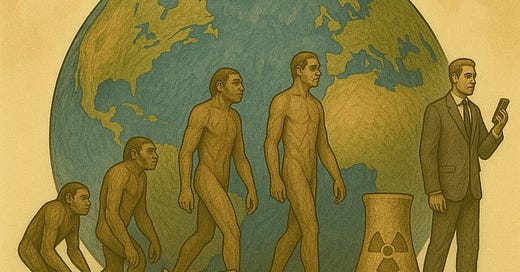Biophysical Realities.
A series of concepts to better understand the world we inhabit and to enable better discussions.
Something a bit more philosophical today.
I have been mulling over the trajectory of humanity for some time now. How did we get to this point? What drives us? Is there a way to decouple our energy metabolism from our ecology? What does declining energy surplus mean for the future?
So many questions.
I started this Substack originally as a bit of hobby to help readers, mostly friends and family, develop more nuanced energy literacy. This was born out of frustration with what I was seeing described in the news, and partly out of concern for our trajectory in New Zealand. This Substack is about fostering awareness, promoting conversations, and learning a few things together along the way.
The Substack has surged in popularity lately, so clearly there is interest in these topics. As such I feel it is timely to map out the fundimental principles at the basis of our lives as I see them, and to invite a conversation about our furture.
It is my hope that this thesis can be used to better interpret the energy landscape we live in and in doing so have more productive conversations based in reality.
Discussions that recognise that the world we live in is essentially not the result of some conscious design but more one of humanity being carried along by the innate forces of biology and physics.
Over time it has also become increasingly apparent to me that modernity and the abundance we enjoy has obscured our understandings of the fundimental biological and physical constraints of life on earth. We are energy blind.
Disclaimer - I am taking some creative license with the terms I use and how I describe various concepts in order to simplify them for the general understanding by the widest possible audience.
Biology
Human existence, like all other life on earth, is rooted in biology and constrained by physics. It is in this context that we can best understand energy and its implications in our lives.
Humans are biological organisms, we have been shaped by evolution, genetics and the foundational relationships developed with earths ecology.
As biological organism we are hardwired with innate and primordial programming. This programming has one objective, to project the human genome forward in time, which is the definition of survival at a species level.
This is achieved by utilising evolutionary strategies that select for “fitness”.
Fitness in this context is defined as maximum energy accumulation, otherwise known as the “Maximum Power Principle”.
“The maximum accumulation of energy allows maximum reproductive output which is, after all, what natural selection is based on.” - Charles Hall
When considering the environment around us we often talk about adaptation and marvel at the features that various plants or animals have developed to occupy certain ecological niches.
At their core these adaptations are all oriented towards energy, specifically maximising the accumulation and throughput of energy within the niche and in doing so out competing other organisms trying to inhabit the same niche.
Humanity functions in the same way although in the modern context we call our niches “markets”. We self organise to identify a niche (new market) and maximise the energy (flows of money) within the niche to out complete others also trying to capture the niche.
Evolution is oriented towards energy.

Physics
All biological life on earth, including humans, operate within the constraints of physics.
Thermodynamics define the physics of energy, work and entropy.
I don’t particularly like the term “thermodynamics” as it sounds overly complex and switches most people off. But in essence it is what we all implicitly know, most of us just don’t realise we know it.
Remember from high school that energy cannot be destroyed it can only be transformed? That’s what we are talking about here.
The reason I say we know it, we just don’t know that we know it, is because we all understand that if we get something out of the freezer it defrosts, or if we kick a ball it will eventually stop, or that as time goes on things need more maintenance. Observations that are all a function of thermodynamics.
So, let’s recap as simply as possible.
Thermodynamics describes energy, heat, and work, and how they interact in physical and biological systems. It explains how energy moves and changes form, governing everything from engines, air conditioning units, to stars, and biological processes.
The Laws of Thermodynamics:
First Law – Energy cannot be created or destroyed, only transferred or transformed. (Conservation of energy.)
Example - The petrol in your car gets transformed into motion, heat, and noise that is equal to the original energy content of the petrol.
Second Law – Energy naturally dissipates through an increasing series of transformations over time. This is also known as disorder, or entropy. Low entropy energy dissipates to become less ordered, and less useful, higher entropy energy.
Example 1 - Why a ball eventually comes to rest after you kick it. The kinetic energy transferred to the ball by by your foot is transformed into an ever-increasing series of energy transactions until all the kinetic has been dissipated and the ball comes to rest. The energy transactions in this example include distortion of the ball, displacement of blades of grass, friction heat transfer with the air, noise, etc.
Example 2 - Why steel rusts. Iron reacts with oxygen and water to form rust, which is a more disordered (higher entropy) state than pure iron. This process is driven by the tendency of systems to maximise entropy.
The second law explains how low entropy primary energy is dissipated into high entropy, less useful forms. We typically refer to this as losses when we are talking about our energy systems. For example transmission losses when we move electricity over large distances. It also explains why everything decays and needs constant maintenance.
Entropy can also be thought of as disorder. Low entropy energy is highly ordered. Low entropy primary energy is generally highly energy dense and not highly disperse. It can easily be contained and deployed for the purposes of work. High entropy energy in contrast is highly disperse, less dense and more chaotic. It can’t easily be applied to provide useful work.
Note - There are four official laws of thermodynamics, including a zeroth law and a third law, but they are not really required to explain what I am trying to convey here.
Maximum Power - The integration of biology and physics.
Viewing life as a biological framework overlaid with energy transactions we are confronted with the biophysical reality that all life on earth is functioning within an open thermodynamic system exchanging matter and energy with the environment.
Humans and all other lifeforms are no different in this respect. We all take in low entropy energy such as food and sunlight to do work (move) while simultaneously producing high entropy waste streams.
Similarly, all lifeforms compete to optimise for the energy available in a specific niche. The successful species within the niche, as determined by selection, is the one that can self organise to optimise for useful energy flow (power) within the niche.
The Maximum Power Principle in evolutionary selection means that organisms that self organise to maximise the useful energy flow (power) in their environment are more likely to survive and reproduce, leading to natural selection for traits or strategies that are directed towards energy accumulation and throughput.
The Maximum Power Principle is in essence survival through the accumulation of surplus energy.
If we are all subject to the decaying effects of entropy (2nd law of thermodynamic), in order to survive we need both the energy to maintain and a surplus after maintenance with which to grow. The greater the surplus, the greater the potential for growth, or increased evolutionary fitness.
Since the time in our human evolutionary journey that we developed the ability to communicate, we have been able to collaborate and coordinate to out compete every other species on the planet.
In doing so our primary competitors have became each other.
As such the way we interact with each other and the world around us emerges from the conditions described by the maximum power principle.
By understanding biology, and the physics, we can summarise our lives on this blue green planet as being dictated by the following:
We exist within an open thermodymanic system that requires both the energy to maintain and the energy to grow.
Maintaining our built world will require ever more energy due to the effects of decay (entropy).
In order to grow, and in doing so survive, societies will self organise to dissipate an energy gradient in a way that optimises for the maximum rate of energy capture and use. This is a strategy designed to provide the greatest energetic surplus at any moment.
Viewing the modern world through this lens.
The fundimental biophysical reality in which we live, as described above, has not changed since the time we emerged from the primordial soup until now.
The only thing that has changed is the energy gradients we have available to dissipate and our ability to exploit them at ever greater rates. We have discovered incredible energy gradients of concentrated ancient sunlight, with such phenomenal energy density, that provide levels of surplus never before seen in human history.
So we keep doing what we have always done since the beginning of time and what we have always been biologically compelled to do. Now we just do it at an incredible global scale and intensity.
Industrialised societies have self organised to extract, convert, and consume fossil fuels (coal, oil, gas) at the fastest possible rate, enabling massive economic and population growth.
Cities are built to concentrate people, resources, and energy flows, enabling higher rates of economic activity and energy transformation per unit area.
Modern industrial agriculture uses tractors, fertilizers, irrigation, and pesticides, all energy intensive input, to maximize crop yields (i.e., maximize power flow per hectare).
Capitalism is just an economic term for the maximum power principle and is oriented towards maximising economic output (GDP), which correlates with total energy throughput (more energy use = more production, more transactions).
Still at the core of it all we are driven by the biological imperative to discover the next energy gradient and to out compete each other in a race for survival.

As the charts above show, we live in a unique time in human history. First came the explosion of energy starting in the late 1800’s, which is the blink of an eye in the span of humanities existence on the planet, followed by an explosion of population growth and production (the processing of energy and materials).
Second order effects
Down stream of this biophysical reality are some other concepts that need to be included when speculation about our future. A brief introduction to these concepts:
Economics is a language we use to describe transactions of energy - The economy is fundamentally an open thermodynamic system that dissipates low entropy energy and materials to produce good, services and high entropy waste streams. Money is a way to codify and value these energy transactions.
Efficiency improvements lead to increased energy use - Jevon’s paradox describes a rebound effect where efficiency gains make things cheaper which in turn leads to more use. In order to meet the maximum power principle biological imperative for growth, efficiency almost always means we do more with a now more efficient process or re-allocate the savings in one domain to increasing some other consumptive activity in another domain.
Energy is not saved, it is relocated - Doomberg’s postulate states that every molecule of fossil fuel produced worldwide will be burned by somebody somewhere, and local efforts to restrict consumption merely relocate the enjoyment of that privilege.
Addition, not transition - Newly discovered energy sources do not displace existing energy sources. The open thermodynamic system of life always requires ever more energy to maintain and to grow. As such every energy source will be dissipated and new sources will always be an addition.
Energy return on energy invested (EROI) needs to increase to avoid collapse - The second law of thermodynamics dictates that society needs both the energy to maintain and the energy to grow. This necessitates increasing the amount of surplus energy available. Surplus energy funds the complexity, services, and quality of life that define advanced societies. If too much of society’s effort goes into just getting more energy, there’s not enough left over for everything else leading to social, economic, and technological contraction.
Abundance is peace, scarcity is war - If resources or energy are scarce, maximising your power (and thus chances of survival or success) often means taking as much as possible before someone else does. This constant evolutionary “arms race” for energy and resources means anxiety about energy and resource sufficiency is adaptive, and cultural narratives (scarcity mentality) often reflect this reality. Inversely during times of abundance, such as we have experienced since the end of World War two there has been relative peace and global cooperation.
It’s no body’s fault.
The natural world is cyclic. Everything is in a state of flux. All things are continually growing, collapsing, and re-growing again all around us.
Humanity is a part of nature, not separate from it. We are being carried by, not steering, the course of nature.
Civilisations have continually emerged and collapsed throughout history. This is not a new or emergent phenomena.
The only choices we have, if there are choices at all, is to grow or collapse. The later is however inevitable at some point.
The world we see around us was not the result of a conscious decision, it is downstream of the biological imperative to maximise for energy throughput - the Maximum Power Principle.
Nate Hagen refers to humanity as a superorganism.
Civilization, he writes, functions like a superorganism—a global web of humans, machines, institutions, and systems acting as one. It’s not conscious, but it behaves as if it is.
It’s blind, hungry, and in charge. It follows energy and momentum, not foresight.
We have to see it for what it is.
For those of us alive at this time, the abundance we experience is unparalleled in human history and for that we can be grateful. However, this time also comes with increasing complexity, increasing externalities and the geopolitical tensions downstream if the scarcity mentality. We are entering a period where we will increasingly struggle to generate the energy surplus necessary to maintain the world as we currently know it.
We have to stop blaming it on each other, governments or some clandestine cabal of global elites. This is nature being played out by humanity who has discovered concentrated sources of ancient sunlight and has unconsciously self organised to optimise for throughput of these energy sources. Energy sources that our ancestors would have viewed as akin to magic.
Individually we can undoubtedly make choices to live a more austere life but we must acknowledge that whatever energy we forfeit will gladly be taken up by someone else wanting to better ensure their future. This is nature, this is biology.
Art Berman sums it up beautifully
Until we see this not as moral failure but as systemic outcome, we’ll keep missing the point.
In that light, collapse isn’t failure. It’s part of the cycle. Systems overshoot. Some burn out. Others adapt. Evolution doesn’t care if the game ends. It just plays it. Calls for foresight and sustainability don’t speak in evolutionary terms. They speak in human values. Ethics. Longing.
Nature is not only balance. It’s also extinction, overshoot, and churn. That’s the tension. We celebrate nature’s laws, then ask to override them. It’s like praising the lion and then scolding it for killing the gazelle.
Nature doesn’t do oughts. It just is.

Better discussions.
It is only when we understand this biophysical reality that we are able to see our place in the world and this time in history more clearly.
Do we continue to grow exponentially collapsing suddenly and violently, like a locust storm, or do we somehow soften the landing? Do we bend and not break as Nate Hagens describes it?
It is only from appreciating that this is the starting point that we can begin to have better discussions.
We have to abandon the fantasies of perpetual compounding growth and start to realistically assess the pathway ahead.
In reading my Substack you could be forgiven for believing that I have a very negative view of renewables. This is not entirely true. I like them for a decentralised off grid approach to living which may become very important in the future. But at scale they produce less surplus energy than the systems that proceeded them, as such they ultimately speed up the inevitable contraction. Honestly ask yourself, is there a single country aggressively pursuing net zero and maintaining growth in real terms?
We need more time to mature our discussions and recognise that life will change radically as our energy systems produce less surplus in the future. We are alive at a time of unparalleled abundance provided by concentrated reserves of ancient sunlight. Reserves that are depleting and providing less surplus. We are at an apex.
New Zealand is a case study for this scenario as we now produce half the natural gas that we did only 3-4 years ago but have not been able to replace it with another energy source. The effects are being acutely felt in our electricity generation and industrial sectors. Growth has essentially stopped and it is only government expenditure funded by debt that maintains the illusion of modest GDP growth.
What is the pathway back to surplus?
In the absence of significant energy growth there isn’t one. It’s that simple. Where will the necessary growth come from in the absence of energy?
Now is not the time for fantasies of growth underwritten by wildly complex and equally fragile renewable systems. Now is the time to prepare. To develop the longest off ramps possible.
The future will be much simpler and less energy intensive.
Some of the questions we should be pursuing in our discussions are:
Can we decouple our biology from the maximum power principle and what would the implications be of doing so be? Would we devolve and become extinct over time?
If we could achieve this decoupling from the maximum power principle would there be more of a tendency away from the scarcity mindset and a shift towards greater collaboration?
How do 8 billion people live within the limitations of the daily flows of energy? The last time we did that the population was less the one billion?
How do we avoid the hunger games or mad max scenarios at either end of the spectrum as the global economy ceases to grow and we transition to a less energy intensive future?
Is there a pathway to greater individual sovereignty through decentalisation, simplification and more regional regenerative communities?
How do we manage existing built complexity as we simplify? When do assets become liabilities without the energy to maintain them?
Are we already experiencing the early stages of a catabolic collapse? Are trends of de-industrialisation baked in and how long can we borrow to fund public services while running year on year deficits?
What timeframes do we have and how best do we allocate resources to prepare?
I do see a pathway to what could be a better future, a future of closer communities, richer relationships and a life more aligned with our humanity. A future where perhaps we know our neighbours better, we rush less and we reflect more. A future where we notice the black birds nest in the hedge or the very first shoots on the trees in spring.
It won’t be easier, it will be hard and brutal, but it may be richer.
Perhaps I am just getting old and my thoughts are overly romantic, as I equally see many dangers on the path to different future.
Either way these are the discussions we need to be having, not these ridiculously desperate hopes that we can have continue to grow endlessly powered by wood pellets and bio-diesel.
The new conversations need to be grounded on the following principles:
It’s no body’s fault.
Start with biophysical realities, not magical thinking.
We have to not take it personally and engage with people from across the isle.
We need to create the future and to acknowledge that its going to be different to what we have had.
Everything in the world is cyclic. Humanity its about to start a new cycle. What would we like it to look like?
Thanks for reading.
Larry






Awesome read and erudite analysis. Many thanks. Larry, you are what one might call an energy determinist. Personally, I think that new science and new, renewable, energy technologies will solve the shortage of low entropy sources. The fact of their existence (currently unrecognised in our planetary 'hermit state') is demonstrated by UAP's in their hundreds and thousands passing by this waystation on their cosmic tourism.
UK energy analyst David Turver has just posted an article on the same theme of increasing energy scarcity, also including a reference to Doomberg: https://davidturver.substack.com/p/politics-downstream-of-energy.
“We are being forced to move backwards to high-entropy, diffuse sources of energy like wind, solar and wood pellets so societal EROI is falling.
…
The impact of reduced energy consumption will be slow at first as the assets and wealth accumulated over the 200 years of the industrial revolution take time to dissipate or be sold off. But as energy becomes scarcer and the disorder in the low-EROEI energy system rises, the fruits of the energy revolution and society itself begin to decay and we might expect disorder in society to rise too. A stagnant or contracting economic cake likely means civil unrest will rise and crime will become more widespread. In effect societal entropy increases as energy consumption falls.
…
This is not sustainable and governments will soon find that you cannot print energy. We should not under-estimate the scale of societal disruption that will occur as our energy supply declines. Unless we rapidly change course we are heading for a monetary and energy system reset.”